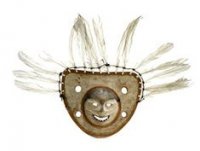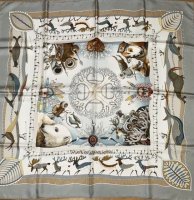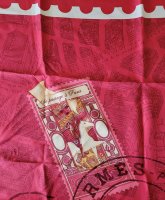I just love this on you, Nomad,and the scarf is perfect with this gorgeous corally sweater. What is CI, please?Not coming up with it.Sotd on theme. The second of my three CI’s. Figured I’ll wear them all this week haha. I haven’t worn this one sadly And I bought it last July :-/. I thought it was red blue and yellow.Apparently it is not a red, but an orange. And the problem with living in a cold weather state is that I own tons of heavy duty clothing. All from before scarf buying. So turtleneck sweaters ( and many chunky as can be seen here lol) make up the bulk of my sweater chest. I hate bundling up with bulky down coats So I often just do a long sleeve shirt under a chunky turtleneck sweater and off I go into the 30/40 degree weather. So today I am experimenting with a scarf on this chunky. It’s 39 today.
View attachment 5274021
You are using an out of date browser. It may not display this or other websites correctly.
You should upgrade or use an alternative browser.
You should upgrade or use an alternative browser.
Scarves Scarf of the Day 2021 - Which Hermès scarf are you wearing today?
- Thread starter bunnycat
- Start date
TPF may earn a commission from merchant affiliate
links, including eBay, Amazon, and others
- Status
- Not open for further replies.
More options
Who Replied?Thank you for your sweet words @monteverdi! And thanks to all for the likes and nice comments on my post!Stunning on you!
This is such a beautiful and unexpected cw @Cookiefiend! It looks amazing on you. Thank you for showing the artist at work!Wearing today La Danse des Chevaux by Jean-Louis Sauvat. I love his work - the lines and movement of color are so beautiful.
View attachment 5274955
View attachment 5274954
View attachment 5274959
View attachment 5274956
Really lovely and perfect with that fabulous sweater @Nomad!Sotd my third and last CI.
and @xincinsin thanks so much for pointing out that CI had that metallic gold. I love the metallic gold in the fuschia CI (I think is the one) The most! But don’t own it.
View attachment 5275008
Beautiful and spectacular cws for each one @Living.la.vida.fifi -- I can never tire of seeing Tapis Persans! (And thank you for inspiring me to show my Iris!).Ndop was created by the Anamorphée duo basing their design on the Ndop ceremonial textiles produced by the Bamileke people of the Central African region of Cameroon. The process that the Bamileke women use to create these textiles is an interesting one. They begin with a basic fabric of strip-woven cotton upon which the artisans stitch resist designs in raffia thread. The cloth is then dyed with indigo coloring after which the raffia stitches get unpicked to reveal geometric patterns of white resist against the dark blue background. The striking linear, abstract patterns follow traditional tribal styles and pictorial symbols.
Below, some pics of the scarf followed by Bamileke Ndop cloth.
View attachment 5275073
View attachment 5275075
View attachment 5275074
Les Fêtes du Roy Soleil was designed by Michel Duchène as a tribute to the rich cultural heritage of the French monarchy, specifically the magnificent reign of Louis XIV. The illustration presents various elaborately dressed courtiers and performers at the royal pageants, galas and spectacles which took place at the Court of Versailles.
The elaborate court ceremonies were not only diversions and entertainment but also an opportunity to showcase the glory and power of the king and were created by the greatest artists of the age as well as by artisans dedicated to creating these productions. Fanciful theatrical stage settings are the backdrop for richly costumed processions, equestrian tournaments, theatre performances, church ceremonies and spectacular firework displays.
I own three CWs of this magnificent design. Following some scarf pics, a collage of period engravings of these courtly events as well as a modern artistic rendition of Louis and his court during a pageant. Top left is a period illustration of a carousel performed by the Sun King in front of the Tuileries in 1662.
View attachment 5275084
View attachment 5275076
View attachment 5275077
Tresors du Nil, or Treasures of the Nile was designed by Joachim Metz inspired by the art, jewelry, murals and objects found in the excavated palaces and funereal chambers of Egypt’s Nile Valley.
Following pics of the scarf, a collage of a few pieces that appear pictured on the scarf. Beginning at the upper left and moving clockwise: the funereal mask of King Tutankhamun, a bejeweled winged scarab pectoral and the Eye of Horus pendant from King Tut’s tomb; a Goddess Maat mural from Queen Nefertari’s tomb and a pair of earrings belonging to Queen Twoset.
View attachment 5275078
View attachment 5275079
View attachment 5275080
Finally, Tapis Persans by Pierre Marie takes inspiration from traditional Persian carpets and textiles. The Hermès catalog states, “The history of Persian carpets dates back thousands of years, beginning with the nomadic peoples of the steppes of central Asia… The oldest surviving example – the celebrated Pazryk carpet from the Altai mountains (4th century BCE) – is an eloquent testament to its creators’ aesthetic sensibility… Persian rugs became enormously popular in Europe from the 13th century onwards. They were used to cover tables and chests, and as wall hangings… This carré presents a particularly fine example, inspired by a prayer rug from northern India… Artist Pierre-Marie has taken inspiration from rugs like these, and the superb Indian archives at the Museum of Textile Printing in Mulhouse, France.”
Below, after pics of the scarf, a collage of pictures showing details of prayer rugs from Northern India.
View attachment 5275082
View attachment 5275081
View attachment 5275083
This is such a spectacular cw and I absolutely love the pink with your animal print top in b/w. I adore that combo @hotgalaxy. I can't do mirror selfies either-- just all I seem to see is my hand! You seem to have it figured out.Off Theme, last week's theme is a better interpretation of this beauty. I have posted two photos. The one with the phone over my face is closest to the scarf colour in reality. One day I will master the selfie View attachment 5275107View attachment 5275108
Just gorgeous @Julide! Those neutrals are TDF...An amazing intro Fifi!everyone has shared some amazing examples. Really wonderful and I have learned so much about some of my favourite designs! I’m sharing a picture of a design that imitates one of my favourite designs.
View attachment 5275271View attachment 5275272View attachment 5275273
Fantastic photos and a beautiful scarf @Nahreen. Just love your "Scarf Fridays"I too decided on my Robert Dallet scarf for this weeks scarf Friday, Dans L´Atelier de Robert Dallet. I was fortunate to visit Paris when they had the Robert Dallet exhibition at FSH.View attachment 5275334
It always makes me think of the amazing cats we have been fortunate to spot on our safari trips to SA, Tanzania and India. I actually brought this scarf with me to our last safari in SA four years ago.View attachment 5275337View attachment 5275338

My SOTD on theme today is the last Aline Honore I acquired in 2021-- La Vie du Grand Nord. Apart from having two of the sweetest faces in all of Hermes' Silken Animalia, the scarf depicts Yup'ik masks and a feather dance fan, emblems of the Inuit culture of the north. I found an interesting photo of a mask from the Smithsonian collection that looks like it inspired Honore's design (top center upside down in photo).

From the story behind:
"In the glacial immensity of the ice field, the light transforms each being and each object into a magical and glowing apparition. Everything which exists has a soul and the birch, a sacred tree, connects man with the cosmos. Life for the Inuit and the Yupiit depends on animals. Those they hunt or fish and those which help them in these tasks occupy the space of this carré, just as much as the men and women with their open, smiling faces。Each object is infinitely poetic, whether the mask of the Moon Spirit, a Yup'ik mask which allows the spirits of animals to join the human world, or else the dance fan made from goose and swan feathers."

(For @Redbirdhermes and any other fellow birch tree lovers, note the beautiful bark frame!)
I paired this with a neck warmer for an appropriately northern mod shot, but am actually wearing it tonight with something less arctic!


From the story behind:
"In the glacial immensity of the ice field, the light transforms each being and each object into a magical and glowing apparition. Everything which exists has a soul and the birch, a sacred tree, connects man with the cosmos. Life for the Inuit and the Yupiit depends on animals. Those they hunt or fish and those which help them in these tasks occupy the space of this carré, just as much as the men and women with their open, smiling faces。Each object is infinitely poetic, whether the mask of the Moon Spirit, a Yup'ik mask which allows the spirits of animals to join the human world, or else the dance fan made from goose and swan feathers."

(For @Redbirdhermes and any other fellow birch tree lovers, note the beautiful bark frame!)
I paired this with a neck warmer for an appropriately northern mod shot, but am actually wearing it tonight with something less arctic!

My late father, who passed away last week after a long illness, was an avid stamp collector. One of the attractions of stamps is that each is a small work of art. Their dazzling array of beautiful designs is always a delight. I purchased this Christmas tree stamp ornament many years ago to honor my dad.

More recently I purchased the Hermès scarf de Passage à Paris because not only do I adore map scarves, but because of its stamp theme. I loved showing it to him.

Remembering Dad on this cold day with de Passage à Paris worn with my warmest winter coat.


More recently I purchased the Hermès scarf de Passage à Paris because not only do I adore map scarves, but because of its stamp theme. I loved showing it to him.

Remembering Dad on this cold day with de Passage à Paris worn with my warmest winter coat.

My late father, who passed away last week after a long illness, was an avid stamp collector. One of the attractions of stamps is that each is a small work of art. Their dazzling array of beautiful designs is always a delight. I purchased this Christmas tree stamp ornament many years ago to honor my dad.
View attachment 5275480
More recently I purchased the Hermès scarf de Passage à Paris because not only do I adore map scarves, but because of its stamp theme. I loved showing it to him.
View attachment 5275481
Remembering Dad on this cold day with de Passage à Paris worn with my warmest winter coat.
View attachment 5275505






I adore La Vie du Grand Nord. What a wonderful posting for your beautiful scarf. Yes, I love birch trees, and they certainly grow Up North. Thank you, LKB.My SOTD on theme today is the last Aline Honore I acquired in 2021-- La Vie du Grand Nord. Apart from having two of the sweetest faces in all of Hermes' Silken Animalia, the scarf depicts Yup'ik masks and a feather dance fan, emblems of the Inuit culture of the north. I found an interesting photo of a mask from the Smithsonian collection that looks like it inspired Honore's design (top center upside down in photo).
View attachment 5275459
From the story behind:
"In the glacial immensity of the ice field, the light transforms each being and each object into a magical and glowing apparition. Everything which exists has a soul and the birch, a sacred tree, connects man with the cosmos. Life for the Inuit and the Yupiit depends on animals. Those they hunt or fish and those which help them in these tasks occupy the space of this carré, just as much as the men and women with their open, smiling faces。Each object is infinitely poetic, whether the mask of the Moon Spirit, a Yup'ik mask which allows the spirits of animals to join the human world, or else the dance fan made from goose and swan feathers."
View attachment 5275467
(For @Redbirdhermes and any other fellow birch tree lovers, note the beautiful bark frame!)
I paired this with a neck warmer for an appropriately northern mod shot, but am actually wearing it tonight with something less arctic!
View attachment 5275490
Last edited:
Oh yes Sorry- collection imperiales. I wore my green csgm earlier in the week and named it in full then. So sorry. And then I wore my light pink one after this.I just love this on you, Nomad,and the scarf is perfect with this gorgeous corally sweater. What is CI, please?Not coming up with it.
And thank you!! I wouldn’t have believed it worked until I put it on lol
So lovely!An amazing intro Fifi!everyone has shared some amazing examples. Really wonderful and I have learned so much about some of my favourite designs! I’m sharing a picture of a design that imitates one of my favourite designs.
View attachment 5275271View attachment 5275272View attachment 5275273
The scarf is such a beautiful neutral - but omg - these photos are stunning!I too decided on my Robert Dallet scarf for this weeks scarf Friday, Dans L´Atelier de Robert Dallet. I was fortunate to visit Paris when they had the Robert Dallet exhibition at FSH.View attachment 5275334
It always makes me think of the amazing cats we have been fortunate to spot on our safari trips to SA, Tanzania and India. I actually brought this scarf with me to our last safari in SA four years ago.View attachment 5275337View attachment 5275338
Thank you so much sweetheart!Thank you for your sweet words @monteverdi! And thanks to all for the likes and nice comments on my post!
This is such a beautiful and unexpected cw @Cookiefiend! It looks amazing on you. Thank you for showing the artist at work!
Really lovely and perfect with that fabulous sweater @Nomad!
Beautiful and spectacular cws for each one @Living.la.vida.fifi -- I can never tire of seeing Tapis Persans! (And thank you for inspiring me to show my Iris!).
This is such a spectacular cw and I absolutely love the pink with your animal print top in b/w. I adore that combo @hotgalaxy. I can't do mirror selfies either-- just all I seem to see is my hand! You seem to have it figured out.
Just gorgeous @Julide! Those neutrals are TDF...
Fantastic photos and a beautiful scarf @Nahreen. Just love your "Scarf Fridays"

Wow!! I love how you've folded it and managed to get the two sweet faces in there!My SOTD on theme today is the last Aline Honore I acquired in 2021-- La Vie du Grand Nord. Apart from having two of the sweetest faces in all of Hermes' Silken Animalia, the scarf depicts Yup'ik masks and a feather dance fan, emblems of the Inuit culture of the north. I found an interesting photo of a mask from the Smithsonian collection that looks like it inspired Honore's design (top center upside down in photo).
View attachment 5275459
From the story behind:
"In the glacial immensity of the ice field, the light transforms each being and each object into a magical and glowing apparition. Everything which exists has a soul and the birch, a sacred tree, connects man with the cosmos. Life for the Inuit and the Yupiit depends on animals. Those they hunt or fish and those which help them in these tasks occupy the space of this carré, just as much as the men and women with their open, smiling faces。Each object is infinitely poetic, whether the mask of the Moon Spirit, a Yup'ik mask which allows the spirits of animals to join the human world, or else the dance fan made from goose and swan feathers."
View attachment 5275467
(For @Redbirdhermes and any other fellow birch tree lovers, note the beautiful bark frame!)
I paired this with a neck warmer for an appropriately northern mod shot, but am actually wearing it tonight with something less arctic!
View attachment 5275490

Oh my - I'm so sorry for your loss!My late father, who passed away last week after a long illness, was an avid stamp collector. One of the attractions of stamps is that each is a small work of art. Their dazzling array of beautiful designs is always a delight. I purchased this Christmas tree stamp ornament many years ago to honor my dad.
View attachment 5275480
More recently I purchased the Hermès scarf de Passage à Paris because not only do I adore map scarves, but because of its stamp theme. I loved showing it to him.
View attachment 5275481
Remembering Dad on this cold day with de Passage à Paris worn with my warmest winter coat.
View attachment 5275505

What a lovely memory you have though.

Oh my - I'm so sorry for your loss!
What a lovely memory you have though.
Thank you, Cookie.
My late father, who passed away last week after a long illness, was an avid stamp collector. One of the attractions of stamps is that each is a small work of art. Their dazzling array of beautiful designs is always a delight. I purchased this Christmas tree stamp ornament many years ago to honor my dad.
View attachment 5275480
More recently I purchased the Hermès scarf de Passage à Paris because not only do I adore map scarves, but because of its stamp theme. I loved showing it to him.
View attachment 5275481
Remembering Dad on this cold day with de Passage à Paris worn with my warmest winter coat.
View attachment 5275505
 I am sorry for your loss. Wishing you love and beauty all around you
I am sorry for your loss. Wishing you love and beauty all around you 
My late father, who passed away last week after a long illness, was an avid stamp collector. One of the attractions of stamps is that each is a small work of art. Their dazzling array of beautiful designs is always a delight. I purchased this Christmas tree stamp ornament many years ago to honor my dad.
More recently I purchased the Hermès scarf de Passage à Paris because not only do I adore map scarves, but because of its stamp theme. I loved showing it to him.
Remembering Dad on this cold day with de Passage à Paris worn with my warmest winter coat.
Sad news. My deepest sympathies go out to you.
I am sorry for your loss. Wishing you love and beauty all around you

Sad news. My deepest sympathies go out to you.
Thank you very much for your kind sympathies.
I am sorry for your loss. So glad you were able to share your scarf enthusiasm with your Dad. Treasure the memories.My late father, who passed away last week after a long illness, was an avid stamp collector. One of the attractions of stamps is that each is a small work of art. Their dazzling array of beautiful designs is always a delight. I purchased this Christmas tree stamp ornament many years ago to honor my dad.
View attachment 5275480
More recently I purchased the Hermès scarf de Passage à Paris because not only do I adore map scarves, but because of its stamp theme. I loved showing it to him.
View attachment 5275481
Remembering Dad on this cold day with de Passage à Paris worn with my warmest winter coat.
View attachment 5275505
My late father, who passed away last week after a long illness, was an avid stamp collector. One of the attractions of stamps is that each is a small work of art. Their dazzling array of beautiful designs is always a delight. I purchased this Christmas tree stamp ornament many years ago to honor my dad.
View attachment 5275480
More recently I purchased the Hermès scarf de Passage à Paris because not only do I adore map scarves, but because of its stamp theme. I loved showing it to him.
View attachment 5275481
Remembering Dad on this cold day with de Passage à Paris worn with my warmest winter coat.
View attachment 5275505
My condolences to you on the passing of your dad.
 He must have enjoyed your stamp themed Hermes scarves. May his memory be a blessing for you.
He must have enjoyed your stamp themed Hermes scarves. May his memory be a blessing for you. 
Thank you so very kindlyBeautiful examples and beautiful scarves, Fifi. Such exquisite treasures from France and Egypt. Thank you for your kind comments and please use what you can about Ecosse. I barely scratched the surface of just the jewelry in the design, covering the few jewelry pieces arranged in the four circles and leaving out mention of the other pins, the use of Scottish agate, and of course, thistle jewelry. I look forward to your IG write up.
It it such an amazing scarf! Incredible colors and graphicsOff Theme, last week's theme is a better interpretation of this beauty. I have posted two photos. The one with the phone over my face is closest to the scarf colour in reality. One day I will master the selfie View attachment 5275107View attachment 5275108
Dear Fifi, I‘m looking forward to both the tutorial as well as the flat pic.Dear Susie, I will share a tutorial on that knot that I call the Pierrot Collar knot as well as the pic of my Parade de Leonhardi flat that you requested.
You wear it so beautifully… It is a silken masterpiece
A timeless classic
Love the colors, too… that particular shade of slate-ish green is fabulous… and the red tartan! Perfect holiday scarf

You and many others here are so knowledgeable about our beloved scarves. Couldn‘t you and other sages give some kind of online lecture that a mere mortal like me could attend? While listening to that lecture I would be kept from looking for more scarves for a while and learn a lot, and both Mr. Susie as well as my credit card would appreciate that very very much!

[/QUOTE]
Please hang tight, dear Susie… I have a very busy week, but promise to share the tutorial and pic of Leonhardi… Your lovely comments are humbling, indeed
My dear Cookie, such a beautiful sentiment here… I am so deeply humbled and happy by your words
Haha! We ALL bow before Croisette and her vast and exquisite collection and long history as an H collector
Such sweet and valuable words… Thank you ever so much! Iris is a masterpiece and magnificent in all formats and CWs, but I must agree that is positively ethereal and sublime in mousseline form
A coveted design that is a work of art
Love the variety and amazing examples in this post… I need a Cirque Molier… Such a fabulous, dynamic, painterly design!
I am so glad that you posted about Ecosse as I plan to feature the design on my IG for Christmas and you have just made my work describing it a lot easier as I will take note of examples, if that is ok with you. It is an extraordinary design and beautiful in this CW
So fabulous! Truly a work or art… I regret not owning the 90 version
Love this scarf and the way you wear it… It is so painterly and almost reminds me of the movement and fluidity of Degas’ horses
Love this so much! You are so lucky to own these beauties
[/QUOTE]
❤️❤️❤️
I started reading your post thinking Ndop is such an amazing scarf, and so lovely folded… then thought “OH - Tapis Persan! That’s a great one for this week, no one has posted it yet! Tomorrow, tomorrow!“ And then I saw your beautiful Tapis Persans!

A day late and a dollar short again - but I ain’t mad - you and your scarves are too beautiful.

Girl - you’re doing just fine! So beautiful, and - oh - how I love pink scarves! ❤️
[/QUOTE]
Tapis Persans is so amazing! We are so lucky to own this masterpiece
Amazing silk… such a beautiful design and fabulous on youAn amazing intro Fifi!everyone has shared some amazing examples. Really wonderful and I have learned so much about some of my favourite designs! I’m sharing a picture of a design that imitates one of my favourite designs.
View attachment 5275271View attachment 5275272View attachment 5275273
Such extraordinary feline portraits… No one surpasses the mastery of Dallet in his portrayals of these majestic catsI too decided on my Robert Dallet scarf for this weeks scarf Friday, Dans L´Atelier de Robert Dallet. I was fortunate to visit Paris when they had the Robert Dallet exhibition at FSH.View attachment 5275334
It always makes me think of the amazing cats we have been fortunate to spot on our safari trips to SA, Tanzania and India. I actually brought this scarf with me to our last safari in SA four years ago.View attachment 5275337View attachment 5275338
I adore this design… love the bark frame, too…My SOTD on theme today is the last Aline Honore I acquired in 2021-- La Vie du Grand Nord. Apart from having two of the sweetest faces in all of Hermes' Silken Animalia, the scarf depicts Yup'ik masks and a feather dance fan, emblems of the Inuit culture of the north. I found an interesting photo of a mask from the Smithsonian collection that looks like it inspired Honore's design (top center upside down in photo).
View attachment 5275459
From the story behind:
"In the glacial immensity of the ice field, the light transforms each being and each object into a magical and glowing apparition. Everything which exists has a soul and the birch, a sacred tree, connects man with the cosmos. Life for the Inuit and the Yupiit depends on animals. Those they hunt or fish and those which help them in these tasks occupy the space of this carré, just as much as the men and women with their open, smiling faces。Each object is infinitely poetic, whether the mask of the Moon Spirit, a Yup'ik mask which allows the spirits of animals to join the human world, or else the dance fan made from goose and swan feathers."
View attachment 5275467
(For @Redbirdhermes and any other fellow birch tree lovers, note the beautiful bark frame!)
I paired this with a neck warmer for an appropriately northern mod shot, but am actually wearing it tonight with something less arctic!
View attachment 5275490
A beautiful tribute. I am so sorry and send my deepest sympathies. My late father was also a stamps, coins and historical documents collector and so many things remind me of him. The deep and timeless bond we have with our dear dads transcends time and is forever in our hearts. HugsMy late father, who passed away last week after a long illness, was an avid stamp collector. One of the attractions of stamps is that each is a small work of art. Their dazzling array of beautiful designs is always a delight. I purchased this Christmas tree stamp ornament many years ago to honor my dad.
View attachment 5275480
More recently I purchased the Hermès scarf de Passage à Paris because not only do I adore map scarves, but because of its stamp theme. I loved showing it to him.
View attachment 5275481
Remembering Dad on this cold day with de Passage à Paris worn with my warmest winter coat.
View attachment 5275505
- Status
- Not open for further replies.
Register on TPF! This sidebar then disappears and there are less ads!
